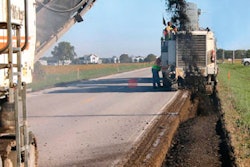When the current highway bill, SAFETEA-LU (Safe, Accountable, Flexible, Efficient Transportation Equity Act: A Legacy for Users), expires in September, 2009, reauthorization needs to be more than just another six-year bill. It needs to be part of a 25-year visionary plan that not only addresses the inadequacies of this country's existing road system, but also supports the future economic growth that will allow the United States to remain a global competitor.
The American Road and Transportation Builders Association (www.artba.org) is making it clear how vitally important a new 25-year federal initiative is to enhance the secure and efficient movement of freight under a proposed Critical Commerce Corridors (3C) Program. The program, according to ARTBA, needs to be led by the federal government and supported by a separate user fee financing mechanism. It should also complement existing core programs in place to maintain the country's existing highway infrastructure.
A short-term fix is not the answer to the accelerated usage the surface transportation system has experienced and will continue to experience. Over the past 25 years, vehicle miles traveled in the United States have doubled and truck travel has increased at a faster rate. But during the same period, lane mile capacity has only increased by 5.2 percent. As a result, increased traffic congestion and bottlenecks at critical freight transfer points across the country have added billions of dollars in lost productivity and wasted motor fuel.
Without a visionary 3C's program, the economic impact could be staggering. Freight tonnage shipped on roadways by truck is projected to double by 2035 and trucking's share of freight tonnage is estimated to grow from 74 to 80 percent.
The initial 3Cs' proposal suggests designated trade corridors, international gateways, access routes to major ports and airports, roadways that carry over-the-road truck traffic significantly in excess of their design specifications, the Interstate Highway System, intermodal connectors, and above all addressing highway truck bottlenecks. The proposal could very well expand the current surface transportation system with truck-only lanes, as well as freight rail lines that would also improve the safety of other motorists by isolating the heavy rigs.
A new freight-based user fee structure would support a new national strategy designed to improve freight movement. If a new national strategy reduces lost productivity and wasted fuel, manufacturers of goods and shippers hired to move those goods will benefit, and remain competitive in the process. They probably will be more than willing, through a user fee arrangement, to invest in a system that reduces waste and improves their competitiveness.
For the United States to remain a global competitor, the 3Cs' program makes sense and it deserves serious consideration. The federal government needs to take the lead in initiating this new federal surface transportation policy, and we all need to support a visionary solution.
Greg Udelhofen, Editor




















